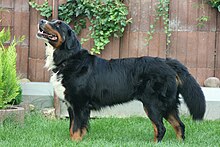Bernese Mountain Dog

Bernese Mountain Dog
|
|||||||||||||||||||||||||||||||||
| Other names | Berner Sennenhund Bernese Cattle Dog |
||||||||||||||||||||||||||||||||
|---|---|---|---|---|---|---|---|---|---|---|---|---|---|---|---|---|---|---|---|---|---|---|---|---|---|---|---|---|---|---|---|---|---|
| Common nicknames | "Berner" | ||||||||||||||||||||||||||||||||
| Origin | Switzerland | ||||||||||||||||||||||||||||||||
|
|||||||||||||||||||||||||||||||||
|
|||||||||||||||||||||||||||||||||
| Domestic dog (Canis lupus familiaris) | |||||||||||||||||||||||||||||||||
| Traits | |||
|---|---|---|---|
| Weight | Male | 80–120 lb (35–55 kg) | |
| Female | 70–110 lb (30–50 kg) | ||
| Height | Male | 24–28 in (61–71 cm) | |
| Female | 22–26 in (56–66 cm) | ||
| Coat | Double | ||
| Color | Tricolor (black, rust, and white) | ||
| Litter size | average 5-7, up to 15 | ||
| Life span | 7–8 years | ||
| Classification / standards | |||
|---|---|---|---|
| FCI | Group 2, Section 3 Swiss Mountain and Cattle Dogs #45 | standard | |
| AKC | Working | standard | |
| ANKC | Group 6 (Utility) | standard | |
| CKC | Group 3 (Working Dogs) | standard | |
| KC (UK) | Working | standard | |
| NZKC | Utility | standard | |
| UKC | Guardian Dogs | standard | |
The Bernese Mountain Dog, called in German the Berner Sennenhund, is a large-sized breed of dog, one of the four breeds of Sennenhund-type dogs from the Swiss Alps. The name Sennenhund is derived from the German Senne (“alpine pasture”) and Hund (“dog”), as they accompanied the alpine herders and dairymen called Senn. Berner (or Bernese in English) refers to the area of the breed’s origin, in the canton of Bern. This mountain dog was originally kept as a general farm dog. Large Sennenhunde in the past were also used as draft animals, pulling carts. The breed was officially established in 1907. In 1937, the American Kennel Club recognized it; today, the club classifies it as a member of the Working Group.
The four breeds of Sennenhund, with the original breed name, followed by the most popular English version of the breed name:
Like the other Sennenhunde, the Bernese mountain dog is a large, heavy dog with a distinctive tri-colored coat, black with white chest and rust colored markings above eyes, sides of mouth, front of legs, and a small amount around the white chest. An ideal of a perfectly marked individual gives the impression of a white horseshoe shape around the nose and a white “Swiss cross” on the chest, when viewed from the front. A “Swiss kiss” is a white mark located typically behind the neck, but may be a part of the neck. A full ring would not meet type standard. The AKC breed standard lists, as disqualifications, blue eye color, and any ground color other than black.
Height at the withers is 24–28 in (61–71 cm) for males, while it is 22–26 in (56–66 cm) for females. Weight is 80–120 lb (35–55 kg) for males, while it is 70–110 lb (30–50 kg) for females.
The Bernese mountain dog is slightly longer than it is tall, and it is highly muscular.
The head of the Bernese mountain dog is flat on the top with a moderate stop, and the ears are medium-sized, triangular, set high, and rounded at the top. The teeth have a scissors bite. The legs of the Bernese are straight and strong, with round, arched toes. The dewclaws of the Bernese are often removed. Its bushy tail is carried low.
...
Wikipedia
